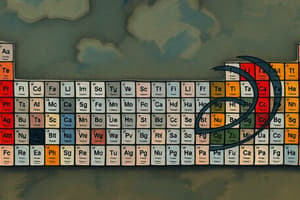Podcast
Questions and Answers
Which pairs of elements exhibit a diagonal relationship in the periodic table?
Which pairs of elements exhibit a diagonal relationship in the periodic table?
- Beryllium (Be) and Aluminum (Al)
- Lithium (Li) and Magnesium (Mg) (correct)
- Boron (B) and Silicon (Si)
- Sodium (Na) and Potassium (K)
What is a characteristic of the diagonal relationship between Lithium (Li) and Magnesium (Mg)?
What is a characteristic of the diagonal relationship between Lithium (Li) and Magnesium (Mg)?
- Existence in the amorphous and crystalline state
- Tendency to form ionic bonds
- Formation of acidic oxides
- Similar electronegativities and covalent character (correct)
What property is exhibited by Beryllium (Be) and Aluminum (Al) as part of their diagonal relationship?
What property is exhibited by Beryllium (Be) and Aluminum (Al) as part of their diagonal relationship?
- Low melting points
- High atomic volumes
- Existence as semiconductors
- Formation of amphoteric oxides and hydroxides (correct)
What is a characteristic of Boron (B) and Silicon (Si) as part of their diagonal relationship?
What is a characteristic of Boron (B) and Silicon (Si) as part of their diagonal relationship?
Why is the diagonal relationship more noticeable amongst the lighter elements?
Why is the diagonal relationship more noticeable amongst the lighter elements?
Which statement is true about the diagonal relationship between the elements in the periodic table?
Which statement is true about the diagonal relationship between the elements in the periodic table?
What is a common characteristic of the elements involved in the diagonal relationship?
What is a common characteristic of the elements involved in the diagonal relationship?
What is the trend for metallic character moving across a period and down a group?
What is the trend for metallic character moving across a period and down a group?
What is the relationship between boiling points and the periodic table trends?
What is the relationship between boiling points and the periodic table trends?
What is the reason for the diagonal relationship between boron and silicon with their diagonally adjacent element pairs?
What is the reason for the diagonal relationship between boron and silicon with their diagonally adjacent element pairs?
What are the characteristics of nonmetals in terms of electron behavior and conductivity?
What are the characteristics of nonmetals in terms of electron behavior and conductivity?
What is the behavior of carbon and phosphorus in terms of bond formation and electronegativities?
What is the behavior of carbon and phosphorus in terms of bond formation and electronegativities?
What is the trend for metallic character across a period?
What is the trend for metallic character across a period?
What is the reason for the diagonal relationship between nitrogen and sulfur?
What is the reason for the diagonal relationship between nitrogen and sulfur?
What is the trend for boiling points across a period?
What is the trend for boiling points across a period?
Flashcards are hidden until you start studying
Study Notes
Periodic Table Trends, Diagonal Relationships, and Metallic Character
- Boron and silicon share similarities with their diagonally adjacent element pairs
- Carbon and Phosphorus can form triple bonds, strong pi and sigma bonds, exhibit allotropes, and have similar electronegativities
- Nitrogen and Sulfur both exhibit diamagnetism
- Diagonal relationship is due to equal polarizing power ionic potential and variation of atomic properties across the periodic table
- Trend moving down the periodic table tends to be opposite of the trend moving across
- Metallic character decreases across a period and increases down a group
- Metals lose electrons easily and are good conductors of electricity and heat
- Nonmetals have a strong pull or attraction to their electrons and are poor conductors
- Metallic character trend follows the atomic radii trend
- Boiling point trend varies on the periodic table in a regular pattern
- Boiling points increase across metals from left to right within a period
- Boiling points decrease sharply when moving from metals to nonmetals on the right
Studying That Suits You
Use AI to generate personalized quizzes and flashcards to suit your learning preferences.




